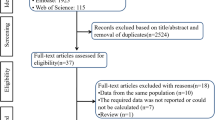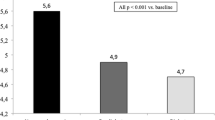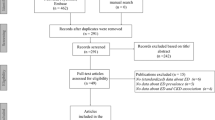Abstract
The association between different antihypertensive drugs and erectile dysfunction (ED) was examined in a cohort of type II diabetes patients identified in the UK General Practice Research Database (GPRD). The GPRD contains details of diagnoses, prescribing, investigations, risk factors, outcomes, and hospital referrals, together with basic demographic information for approximately six million patients from more than 450 representative general practices throughout the UK. A total of 634 cases and 2526 controls were included for analysis. Unconditional logistic regression analysis was performed to assess the risk of ED after adjusting for age at diabetes diagnosis date, cigarette smoking, depression, glycemic control, use of HMG-CoA reductase inhibitors, use of histamine receptor antagonists, use of digitalis medicines, and use of nitrates. Increased risk of ED was observed among patients taking the following antihypertensives: ACE inhibitors (OR=1.47, 95% CI=1.21, 1.80) and alpha blockers (OR=1.54, 95% CI=1.11, 2.12). However, we identified a nearly 30% reduction in risk among patients on diuretics (OR=0.73, 95% CI=0.54, 0.99). No statistically significant increase in risk was observed among users of beta blockers and calcium channel blockers (OR=1.05, 95% CI=0.85, 1.31) and (OR=1.14, 95% CI=0.91, 1.43), respectively. The results of this study confirm the strong and recognized effect of comorbidities in a diabetic population, but also require additional experimental and observational studies to further understand the potential benefit of diuretics and other ED treatments such as PDE5 inhibitors.
This is a preview of subscription content, access via your institution
Access options
Subscribe to this journal
Receive 8 print issues and online access
$259.00 per year
only $32.38 per issue
Buy this article
- Purchase on Springer Link
- Instant access to full article PDF
Prices may be subject to local taxes which are calculated during checkout
Similar content being viewed by others
References
Grimm Jr RH et al. for the TOMHS Research Group. Long-term effects on sexual function of five antihypertensive drugs and nutritional hygienic treatment in hypertensive men and women. Treatment of Mild Hypertension Study (TOMHS). Hypertension 1997; 29: 8–14.
Segraves RT et al. Erectile dysfunction associated with pharmacologic agents. In: Segraves RT, Schoenberg HW (eds). Diagnosis and Treatment of Erectile Disturbances: A Guide for Clinicians. Plenum Medical: New York, 1985; pp 23–63.
Croog SH et al. Sexual symptoms in hypertensive patients. A clinical trial of antihypertensive medications. Arch Intern Med 1988; 148: 788–794.
Burnett WC, Chahine RA . Sexual dysfunction as complication of propanolol therapy in men. Cardiovasc Med 1979; 4: 811–815.
Forsberg L, Gustavii B, Hojerback T, Olsson AM . Impotence, smoking, and beta-blocking drugs. Fertil Steril 1979; 31: 589–591.
van Brummelen P . The relevance of intrinsic sympathomimetic activity for beta-blocker-induced changes in plasma lipids. J Cardiovasc Pharmacol 1983; 5: S51–S55.
Warren SC, Warren SG . Propanolol and sexual impotence [letter]. Ann Intern Med 1977; 86: 112.
Mann KV et al. Sexual dysfunction with B-blocker therapy. More common than we think? Sexual Disabil 1982; 5: 67–77.
Barksdale JD, Gardner SF . The impact of first-line antihypertensive drugs on erectile dysfunction. Pharmacotherapy 1999; 19: 573–581.
Suzuki H, Tominaga T, Kumagai H, Saruta T . Effects of first-line antihypertensive agents on sexual function and sex hormones. J Hypertens 1988; 6: S649–S651.
Stevenson JG, Umstead GS . Sexual dysfunction due to antihypertensive agents. Drug Intell Clin Pharm 1984; 18: 113–121.
Hebel SK, Olin BR (eds). Drug Facts and Comparisons. Facts and Comparisons: St Louis, 1998, p 165f.
Fedele et al. Erectile dysfunction in diabetic subjects in Italy. Diabetes Care 1998; 21: 1973–1977.
The ALLHAT officers and coordinators for the ALLHAT Collaborative Research Group. Major outcomes in high-risk hypertensive patients randomized to angiotensin-converting enzyme inhibitor or calcium channel blocker vs diuretic: the Antihypertensive and Lipid-Lowering Treatment to Prevent Heart Attack Trial (ALLHAT). JAMA 2002; 288: 2981–2997.
Pitts NE . The clinical evaluation of prazosin. In: Cotton DW (ed). Prazosin, Evaluation of A New Anti-hypertensive Agent. Elsevier: New York, 1974: pp 149–163.
Moss HB, Procci WR . Sexual dysfunction associated with oral antihypertensive medication: a critical survey of the literature. Gen Hosp Psychiatry 1982; 4: 121–129.
Williams GH et al. Impact of antihypertensive therapy on quality of life: effect of hydrochlorothiazide. J Hypertens 1987; 5S: 29-S35.
Semmens JP, Semmens FJ . Inadequate vaginal lubrication. Med Aspects Hum Sex 1978; 12: 58–71.
Trimmer E . Sex problems in practice. Iatrogenic sex problems. BMJ (Clin Res Ed) 1981; 283: 953–955.
Adverse reactions to bendrofluazide and propanolol for the treatment of mild hypertension. Report of Medical Research Council Working Party on Mild to Moderate Hypertension. Lancet 1981; 2: 539–543.
Jick H, Jick SS, Derby LE . Validation of information recorded on general practitioner based computerised data resource in the United Kingdom. BMJ 1991; 302: 766–768.
Jick H, Jick SS, Derby LE . Further validation of information recorded on general practitioner based computerised data resource in the United Kingdom. Pharmacoepidemiol Drug Saf 1992; 1: 347–349.
Goldstein I et al. Vardenafil, a new phosphodiesterase type 5 inhibitor, in the treatment of erectile dysfunction in men with diabetes. Diabetes Care 2003; 26: 777–783.
Author information
Authors and Affiliations
Corresponding author
Rights and permissions
About this article
Cite this article
Blumentals, W., Brown, R. & Gomez-Caminero, A. Antihypertensive treatment and erectile dysfunction in a cohort of type II diabetes patients. Int J Impot Res 15, 314–317 (2003). https://doi.org/10.1038/sj.ijir.3901041
Received:
Revised:
Accepted:
Published:
Issue Date:
DOI: https://doi.org/10.1038/sj.ijir.3901041
Keywords
This article is cited by
-
Diabetes and erectile dysfunction
Current Sexual Health Reports (2004)
-
Special considerations in the management of erectile dysfunction in the HIV-positive patient
Current Sexual Health Reports (2004)



